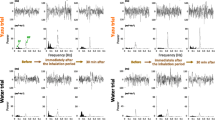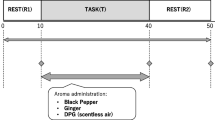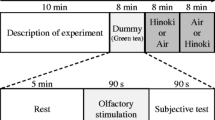Abstract
We investigated the effects of the odor of jasmine tea on autonomic nerve activity and mood states in a total of 24 healthy volunteers. We used the odor of jasmine tea at the lowest concentration that could be detected by each subject but that did not elicit any psychological effects. R–R intervals and the POMS test were measured before and after inhalation of the odors for 5 min. Both jasmine tea and lavender odors at perceived similar intensity caused significant decreases in heart rate and significant increases in spectral integrated values at high-frequency component in comparison with the control (P < 0.05). In the POMS tests, these odors produced calm and vigorous mood states. We also examined the effects of (R)-(−)-linalool, one of its major odor components, at the same concentration as in the tea, and (S)-(+)-linalool. Only (R)-(−)-linalool elicited a significant decrease in heart rate (P < 0.05) and an increase in high-frequency component in comparison with the controls, and produced calm and vigorous mood states. Thus, the low intensity of jasmine tea odor has sedative effects on both autonomic nerve activity and mood states, and (R)-(−)-linalool, one of its components, can mimic these effects.






Similar content being viewed by others
References
Alaoui-Ismaili O, Vernet-Maury E, Dittmar A, Delhomme G, Chanel J (1997) Odor hedonics: connection with emotional response estimated by autonomic parameters. Chem Senses 22:237–248
Brauchli P, Ruegg PB, Etzweiler F, Zeier H (1995) Electrocortical and autonomic alteration by administration of a pleasant and an unpleasant odor. Chem Senses 20:505–515
Brown TE, Beightol LA, Koh J, Eckberg DL (1993) Important influence of respiration on human R-R interval power spectra is largely ignored. J Appl Physiol 75:2310–2317
Buchbauer G (1996) Methods in aromatherapy research. Perf Flav 21:31–36
Buchbauer G, Jirovetz L (1994) Aromatherapy-use of fragrances and essential oils as medicaments. Flav Fragr J 9:217–222
Buchbauer G, Jirovetz L, Jager W, Dietrich H, Plank C (1991) Aromatherapy: evidence for sedative effects of the essential oil of lavender after inhalation. Z Naturforsch 46:1067–1072
Buchbauer G, Jirovetz L, Jager W, Plank C, Dietrich H (1993) Fragrance compounds and essential oils with sedative effects upon inhalation. J Pharm Sci 82:660–664
Chen J (1992) The effects of Chinese tea on the occurrence of esophageal tumors induced by N-nitrosomethylbenzylamine in rats. Prev Med 21:385–391
Doty RL (2001) Olfaction. Annu Rev Psychol 52:423–452
Ehrlichman H, Kuhl SB, Zhu J, Warrenburg S (1997) Startle reflex modulation by pleasant and unpleasant odors in a between-subjects design. Psychophysiology 34:726–729
Elisabetsky EJ, Souza DO (1995) Effects of Linalool on glutamatergic system in the rat cerebral cortex. Neurochem Res 20:461–465
Hardy M, Kirk-Smith MD, Stretch DD (1995) Replacement of drug treatment for insomnia by ambient odour. Lancet 346:701
Heuberger E, Hongratanaworakit T, Bohm C, Weber R, Buchbauer G (2001) Effects of chiral fragrances on human autonomic nervous system parameters and self-evaluation. Chem Senses 26:281–292
Ho CT, Chen Q, Shi H, Zhang KQ, Rosen RT (1992) Antioxidative effect of polyphenol extract prepared from various Chinese teas. Prev Med 21:520–525
Inoue N, Kuroda K, Sugimoto A, Kakuda T, Fushiki T (2003) Different autonomic nervous responses according to preference for the odor of jasmine tea. Biosci Biotechnol Biochem 67:1206–1214
Ito Y, Sugimoto A, Kakuda T, Kubota K (2002) Identification of potent odorants in Chinese jasmine green tea scented with flowers of Jasminum sambac. J Agric Food Chem 50:4878–4884
Jager W, Mayer M, Platzer P, Reznicek G, Dietrich H, Buchbauer G (2000) Stereoselective metabolism of the monoterpene carvone by rat and human liver microsomes. J Pharm Pharmacol 52:191–197
Jager W, Mayer M, Reznicek G, Buchbauer G (2001) Percutaneous absorption of the monoterpene carvone: implication of stereoselective metabolism on blood levels. J Pharm Pharmacol 53:637–642
Jellinek JS (1997) Psychodynamic odor effects and their mechanisms. Cosmet Toilet 112:61–71
Kada T, Kaneko K, Matsuzaki S, Matsuzaki T, Hara Y (1985) Detection and chemical identification of natural bio-antimutagens. A case of the green tea factor. Mutat Res 150:127–132
Kubota M, Ikemoto T, Komaki R, Inui M (1992) Proceedings of the 12th International Congress on Flavours, Fragrances and Essential Oils, Vienna 4–8 October, 1992. Austrian Associaton of Flavour and Fragrance Industry, Vienna, pp 456–81
Laska M, Liesen A, Teubner P (1999) Enantioselectivity of odor perception in squirrel monkeys and humans. Am J Physiol 277:R1098–R1103
Lis-Balchin M, Hart S (1997a) A preliminary study of the effect of essential oils on skeletal and smooth muscle in vitro. J Ethnopharmacol 58:183–187
Lis-Balchin M, Hart S (1997b) Correlation of the chemical profiles of essential oil mixes with their relaxant and stimulant properties in man and smooth muscle preparations in vitro. In: Franz C, Mathe CA, Buchbauer G (eds) Proceedings of the 27th International Symposium on Essential Oils, Vienna, Austria, 8–11 September. Alured Publishing, Carol Stream, pp 24–28
Lis-Balchin M, Hart S (1999) Studies on the mode of action of the essential oil of lavender (Lavandula angustifolia P. Miller). Phytother Res 13:540–542
Lorig TS (1989) Human EEG and odor response. Prog Neurobiol 33:387–398
Moritani T, Hayashi T, Shinohara M, Mimasa F, Shibata M (1993) Comparison of sympatho-vagal function among diabetic patients, normal controls and endurance athletes by heart rate spectral analysis. J Sports Med Sci 7:31–39
Moritani T, Hayashi T, Shinohara M, Mimasa F, Masuda I, Nakao K (1995) Sympatho-vagal activities of NIDDM patients during exercise as determined by heart rate spectral analysis. In: Kawamori R, Vranic M, Horton ES, Kubota M (eds) Glucose fluxes, exercise and diabetes. Smith-Gordon, London, pp 91–96
Nagai M, Wada M, Usui N, Tanaka A, Hasebe Y (2000) Pleasant odors attenuate the blood pressure increase during rhythmic handgrip in humans. Neurosci Lett 289:227–229
Novak V, Novak P, de Champlain JC, le Blanc AR, Martin R, Nadeau R (1993) Influence of respiration on heart rate and blood pressure fluctuations. J Appl Physiol 74:617–626
Saeki Y (2000) The effect of foot-bath with or without the essential oil of lavender on the autonomic nervous system: a randomized trial. Complement Ther Med 8:2–7
Schwartz RK (1979) Olfaction and muscle activity: an EMG pilot study. Am J Occup Ther 33:185–192
Suzuki M, Aoki T (1994) Effects of volatile compounds from leaf oil on blood pressure after exercising. Mokuzai Gakkaishi 40:1243–1250
Torii S, Fukuda H, Kanemoto H, Miyanchi R, Hamauzu Y, Kawasaki M (1988) Contingent negative variation (CNV) and the psychological effects of odour. In: Van Toller S, Dodd GH (eds) Perfumery—the psychology and biology of fragrance. Chapman& Hall, London, pp 107–120
Tsuchiya T, Tanida M, Uenoyama S, Nakayama Y (1992) Effects of olfactory stimulation with jasmine and its component chemicals on the duration of pentobarbital-induced sleep in mice. Life Sci 50:1097–1102
Van Toller S, Behan J, Howells P, Kendal-Reed M, Richardson A (1993) An analysis of spontaneous human cortical EEG activity to odours. Chem Senses 18:1–16
Wang ZY, Das M, Bickers DR, Mukhtar H (1988) Interaction of epicatechins derived from green tea with rat hepatic cytochrome P-450. Drug Metab Dispos 16:98–103
Yang TT, Koo MW (1997) Hypocholesterolemic effects of Chinese tea. Pharmacol Res 35:505–512
Yokoyama K, Araki S (1994) POMS Japanese manual (in Japanese). Kaneko Syoboh (Tokyo)
Yoshino K, Hara Y, Sano M, Tomita I (1994) Antioxidative effects of black tea theaflavins and thearubigin on lipid peroxidation of rat liver homogenates induced by tert-butyl hydroperoxide. Biol Pharm Bull 17:146–149
Zhang A, Zhu QY, Luk YS, Ho KY, Fung KP, Chen ZY (1997) Inhibitory effects of jasmine green tea epicatechin isomers on free radical-induced lysis of red blood cells. Life Sci 61:383–394
Author information
Authors and Affiliations
Corresponding author
Rights and permissions
About this article
Cite this article
Kuroda, K., Inoue, N., Ito, Y. et al. Sedative effects of the jasmine tea odor and (R)-(−)-linalool, one of its major odor components, on autonomic nerve activity and mood states. Eur J Appl Physiol 95, 107–114 (2005). https://doi.org/10.1007/s00421-005-1402-8
Accepted:
Published:
Issue Date:
DOI: https://doi.org/10.1007/s00421-005-1402-8




